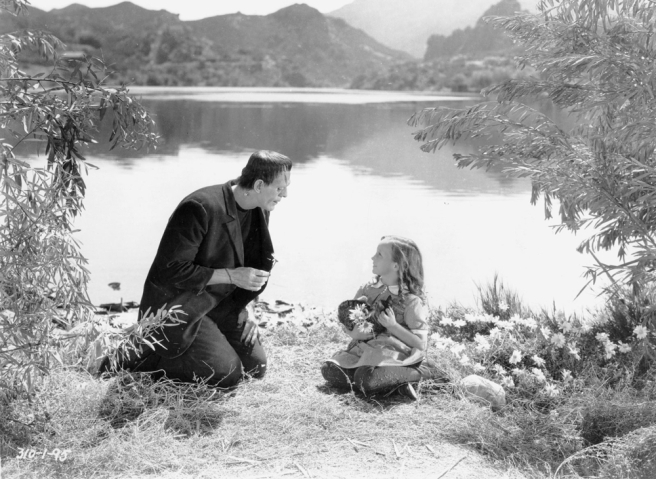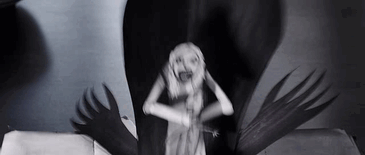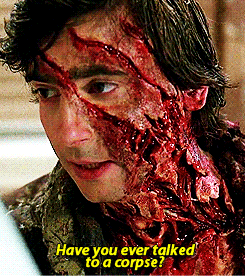
This isn’t about charismatic villains. It isn’t about how we enjoy Freddy Krueger because he snarky and confident even without most of his skin, and forget how he was a child murderer. Then who is sympathetic in Wes Craven’s Nightmare on Elm Street? The parents.
But I digress. There is an abundance of obvious examples from film of sympathetic villains, especially considering classic monster movies. In general, it is easier to put the ugliness on the outside, leaving room for beauty on the inside.
We feel bad for the phantom of the opera because he is disfigured and wants to be loved (and needs a lesson on consent). Frankenstein’s monster has a moment with the little girl on the lake, displaying his innocence, tossing flowers freely like a child himself. Even Frankenstein himself is guilty of curiosity, something that is necessary for technology, science, and society to advance.

Fast forward to the 1970s and 1980s. The vampires of The Lost Boys are deeply loyal to each other. Their only flaw lies in their need to feed, especially for the human inhabitants of Santa Carla. Pinhead and his cenobite companions sacrifice themselves near the end of Hellraiser II after being reminded of their prior humanity. Doug Bradly included, it’s hard not to feel for them in their banal human forms. The pirate ghosts of The Fog want what is rightfully theirs and to take revenge on those who wronged them, even if it’s their descendants. The hero of The Fly is like Frankenstein, except he becomes the monster and loses complete control of his humanity. Even House (as silly as it was) features the ghost of a Vietnam vet who was left to suffer torture when abandoned by a fellow soldier.

These villains are unredeemable, but still sympathetic. Modern examples include Babadook, in which the mother is ultimately at fault: the title monster acts as a physical manifestation of her own depression. Which brings us back to parents. Like cops in action movies (unless the movie is about cops), parents in horror films are barely functional and usually cause or contribute to the core dilemma.

In Hitchcock’s Psycho, the villain, Norman Bates, is quite sympathetic without having the physical deformities of past monsters. In the film, Bates is played by the handsome Anthony Perkins (or Tony Perkins when he was a teen idol, no joke), which makes the audience want to sympathize with him. He’s lonely, sad, and the antithesis of masculinity in many ways, almost a man-child in the most literal sense. He, in his own mind, doesn’t the commit the murders. His mother’s cruel treatment manifests itself as an alternate personality and takes total control by the end. Perhaps it’s his own guilt for killing her, or perhaps it’s just his inability to cope with the abuse he suffered. Norman, kept as a perpetual child, eventually gives in to the mother personality because he believes it to be more significant than his own identity. His mother, not Norman, is ultimately is the villain. Perhaps Norman was the first victim.
In Nightmare on Elm Street, the victims’ parents burn Krueger alive. You can’t help but sympathize with them, did they really do anything wrong? They did, however, take the law into their own hands. They disrupted the order of society, which gets you very dead in horror films.

In Halloween, the bloodline of the Myers house is cursed from druid magic, a price their children have to pay. Even if we strip away the sequels, the parents negligently leave their children alone. Not unlike “The Babysitter and the Man Upstairs” urban legend, and later When a Stranger Calls, which features the same moral problem.

In Child’s Play the well meaning parents ignore their child’s pleas. It irritates us as viewers, but would you believe in an evil doll? The Scream franchise begins and ends with Maureen Prescott’s sexuality. Even though she has a child produced through violent rape, she and her daughter have to pay the price. In The Brood, a woman’s rage produces demon children that only she can quell by essentially forcing down her repressed abuses. Jack Torrence is a raging alcoholic who tries to cope with his past transgressions in The Shining, drawing evil spirits to his family. In Poltergeist, the patriarch of the family buys a home on sour ground leaving his family open to haunting. This is not unlike the father in Pet Cemetery, who merely cannot let go of his lost love ones even though he is partially to blame (and moves them out to the small town in the first place). Even in Pumpkinhead (not exactly a good movie) the title monster is summoned by an angry, mourning father.

In Insidious and its sequel, Josh passes along his gift for astral travel to his son with terrifying results. A hereditary witch cult plays villain in the Paranormal Activity Franchise. Conservative religious attitudes leave the community ripe for murder in Children of the Corn. While the parents pay the ultimate price, it’s hard to imagine He Who Walks Behind the Rows being successful in a hippie college town.
Although horror is, in many ways, preoccupied with ineffectual or even bad parents, what of films that that deal with adults? Sometimes the sin is in our genes, and in human nature itself. Sex spreads a shapeshifting monster like a disease in It Follows. The victims are unaware of what their intimacy will bring, but they ultimately brought it upon themselves (insert classic moral fairytale theory here).

In The Howling, the werewolves are well organized in a secret society but indulge in their carnal desires, not unlike the general assumptions (and possibly facts) we hold about wealthy society. Their violence is instinctual, something that goes back to the deep recesses of the evolutionary chain, something that we humans would rather forget. The same can be said of the hero of An American Werewolf in London (as well as Paris). While in lycanthropic form, the hero finds himself committed atrocities, but he has an excuse. It’s cathartic as much as it is relatable: anger answered with violence, injustice answered with rage.

On the other end of the spectrum, we find human curiosity and greed ultimately causing the downfall of of heroes, or even possibly mankind. In Alien, the Weyland-Yutani Corporation instructs the android Ash to bring a xenomorph back to Earth, even though the logical choice would be to destroy it. While the alien beast would arguable make an effective weapon of mass destruction (and be profitable, of course), what money is there to be had when there is no one left to spend it? The horror of the situation relies not on a greedy board of directors wringing their hands but ultimately profit-margin nonsense. Or perhaps it’s the military cutting corners to save money by dumping waste and creating the monster in The Host.

In The Thing, it’s fair to assume that if the alien ship had been left alone that the title monster would have never been released in the first place. In Prince of Darkness, the literal essence of evil is excavated and tampered with, causing a Mobius strip of destruction. Herbert West in Re-animator, not unlike Dr. Frankenstein, unapologetically continues his research of resurrection in pursuit of scientific discovery. Curiosity wreaking havoc isn’t new, and is the central problem in Flatliners, The Lazarus Effect, As Above So Below, and The Descent, to name a few. Human negligence is often at the core of even zombie films, with radiation being suggested as the cause in Night of the Living Dead, a strange military chemical in Return of the Living Dead, and the lab-created Rage virus in 28 Days Later (as well as its sequel).
Good stories always tell a human story, even if humans are barely involved. By seeing ourselves in both the villains and the heroes, we can mourn our failures and even hope to survive them. Horror is the genre of catharsis, but we cannot work through our darkest fears without seeing at least a small bit of ourselves reflected back in the characters, their suffering, or even in the monsters.


Well this was great. Would you be interested in sharing this with our readers on moviepilot.com?
LikeLike
Absolutely! Thank you for the comment and I would love to share the article.
LikeLiked by 1 person
Hey thanks for the response, and glad to hear it! If you send me an email I can give you the info that you’ll need to get started.
LikeLike